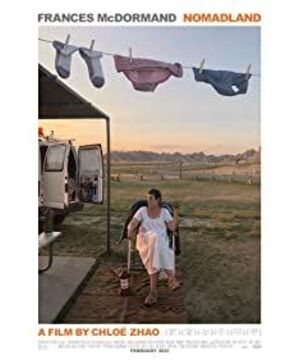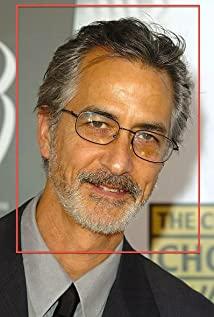"A Place of Nowhere" feels the most simple, and perhaps the most revealing of the director’s intentions, is its (indulgence) use of music: every ten minutes, the heroine’s touring car is in Driving on the highway, or her walking on the open fields, will sound the soft soundtrack of the piano and strings of the TV prose documentary. The music with a clear and prominent theme leads the lonely journey of this widowed middle-aged unemployed woman to an externally lyrical atmosphere. It does not even belong to the heroine's emotions when she embarks on the journey, but more like a commentary track added by the director to the film's audiovisual overall. In it, following the character's state in the magnificent natural scenery, her journey is rendered full of unrealistic romance by soft and sensational notes.
The film’s soundtrack and non-ambient sound have several different usage methods and functions: For example, in David Lynch’s film, we can always hear a constant sound that is close to noise. It is not clear. The theme, meaning, and even melody are used as an aid to environmental sound, adding another perceivable dimension to audiovisual; for example, in Terrence Malick’s "Holy Grail Knight", it matches the male protagonist's indulgence The scene of endless and timely music is an orchestral music that is completely opposite to the emotional color of the picture and is gentle and explores the unknown. It extracts the audience's perception from the immersion of the contents of the picture, and begins to think and experience the true mentality of the protagonist under the glitzy appearance; Of course, there is another kind of highlighting and highlighting the theme, and inputting certain emotions, emotions and even concepts set by the creator into the minds of the audience, just like in "The Sons and Daughters of Heroes", when the song "Heroes sings the heroes" sounded At that time, the scene of the heroic sacrifices of green pine, green cypress, stern eyes, and soldiers holding explosives bags into the enemy line appeared in the picture.
In terms of content, there may be a difference between "A Place of Nowhere" and "Children of Heroes", but they essentially use the same soundtrack to render the film's emotions and highlight its core textual theme. Although the straightforwardness caused by this method and content of "shunting" may be a taboo for an art film, it is closely related to the expression goal that the director Zhao Ting intends to achieve in his work sequence.
From her debut novel "The Song That My Brother Taught Me To Sing" to "The Knight", and then to "A Place of Nowhere", Zhao Ting chose three iconic groups in the life of North American society at the bottom of her film: Aboriginals and Israelis. Western riders represented the rural people who were gradually marginalized in modern society, and the homeless who wandered on the road all the year round. They represent groups that have been marginalized, even forgotten, and abandoned in the rapid development of American society. If the first and second parts of these trilogy still have some original ecological vitality to balance the topicality of its social issues, then "A Place Without a Dependence" begins to show the background identity of the characters straightforwardly. , The social class attribute and its distressed living conditions, and he did not hesitate to poetically romanticize these original realism elements but stay on the surface. Music with overly clear directivity is just the externalization of such intentions.
The roughness in the sense of form in "The Songs My Brother Taught Me to Sing" and "The Cavaliers" is largely due to the non-performance "photographic" brought by several amateur actors who played the protagonists: themselves and their characters The consistent temperament fills the film with a lot of naturalistic details, gestures and expressions beyond the artificial design, making the film go beyond the topicality of the text in a state of free flow and have a considerable degree of vitality. It can even be said that it is the true qualities of the actors that set the tone for the film.
The temperament change of "A Place to Nowhere" comes from Francis McDomond, who has rich experience in acting. For Zhao Ting, who is about to direct a superhero movie, having the opportunity to work with mature and experienced actors is a rare experience, and perhaps a must pass. But letting an excellent professional actor who has been accustomed to camera performance abandon the precise front-camera performance consciousness and adapt to the naturalistic flowing action mode is not as easy as imagined, especially how she should use the posture without showing traces. Fill in the huge gap between yourself and the characters that cannot be filled with the usual Hollywood performance model, and retain the infectious naturalism in Zhao Ting's first two works? It should be said that Francis McDomond’s performance is excellent in any American movie, but she still inevitably takes "A Place of Nowhere" away from the natural flow of temperament, and in the end Create an artificial character that has been crafted with inner drama and story. It can even be said that the "swimming" of the soundtrack and the content of the film is largely due to the overlapping of the inherent emotional characteristics of Francis McDomond's "excessive" performance and the soundtrack. Let the audience's senses lose the room for reverberation. This point can be seen at a glance by comparing the rough and delicate subtle contrast between the characters' gestures and the music in "The Songs My Brother Taught Me To Sing".
However, "Nowhere" is not a movie with a strong plot, and it does not provide McDomond with enough plot space to show the dramatic shock of her performance. In order to prevent her from deviating too far from the naturalistic mode expected by the director in the performance of the camera, but must reasonably highlight the image of her central figure, we have seen this way of editing the picture: it is a short state display of repeated rhythms. The character’s dialogue, actions, and the aura that penetrated into it were just a flash, and then they were constantly cut off by the editor’s “scissors”. It seems that the photographic lens is involuntarily avoiding the characters’ words and behaviors in the naturalistic scenes, but only in lyricalization. In the scene, only "dare" to face the complete actions of the characters.
Such editing methods (may also include the live shots and scene scheduling methods changed by the actors' performances) eventually had to eliminate all the details of filming and the naturalistic state of the characters, leaving only the narrative of the characters in the end. A lot of backtracking textual details. Without the rich body language and actual personality characteristics of the characters, the text core of each scene gradually tends to be the same, becoming the central idea that can be summarized in one sentence: "The low-level characters abandoned by society are forced to embark on a journey alone. Pain and sentimental". The charm of the characters in "The Song That My Brother Taught Me To Sing" finally gave way to the social issues of expression in the abstract characters. The final appearance of the film is presented as the state of the characters loaded with the central idea in front of the postcard-like scenery background.
For young directors who will eventually enter the industrialized system, abandoning spontaneous emotional elements and embracing the core of dramatic text is an inevitable trend. Unless they have the strong religious support and emotional abilities of Terrence Malik, any director will eventually face the question of what she or he wants to say. The paradox is that the more you evade or postpone answering it in your heart, the external content of the work will increasingly tend to adopt a macro and unified standpoint and general principles of textual expression, that is, ignoring the subtle and multi-sense contradictions. Emotions and emotions, and began to talk about popular "principles."
It looks sensational and unconventional, but in reality, it is highly likely to follow the viewer's favor.
(First published on the "Iris" WeChat movie public account)
View more about Nomadland reviews









